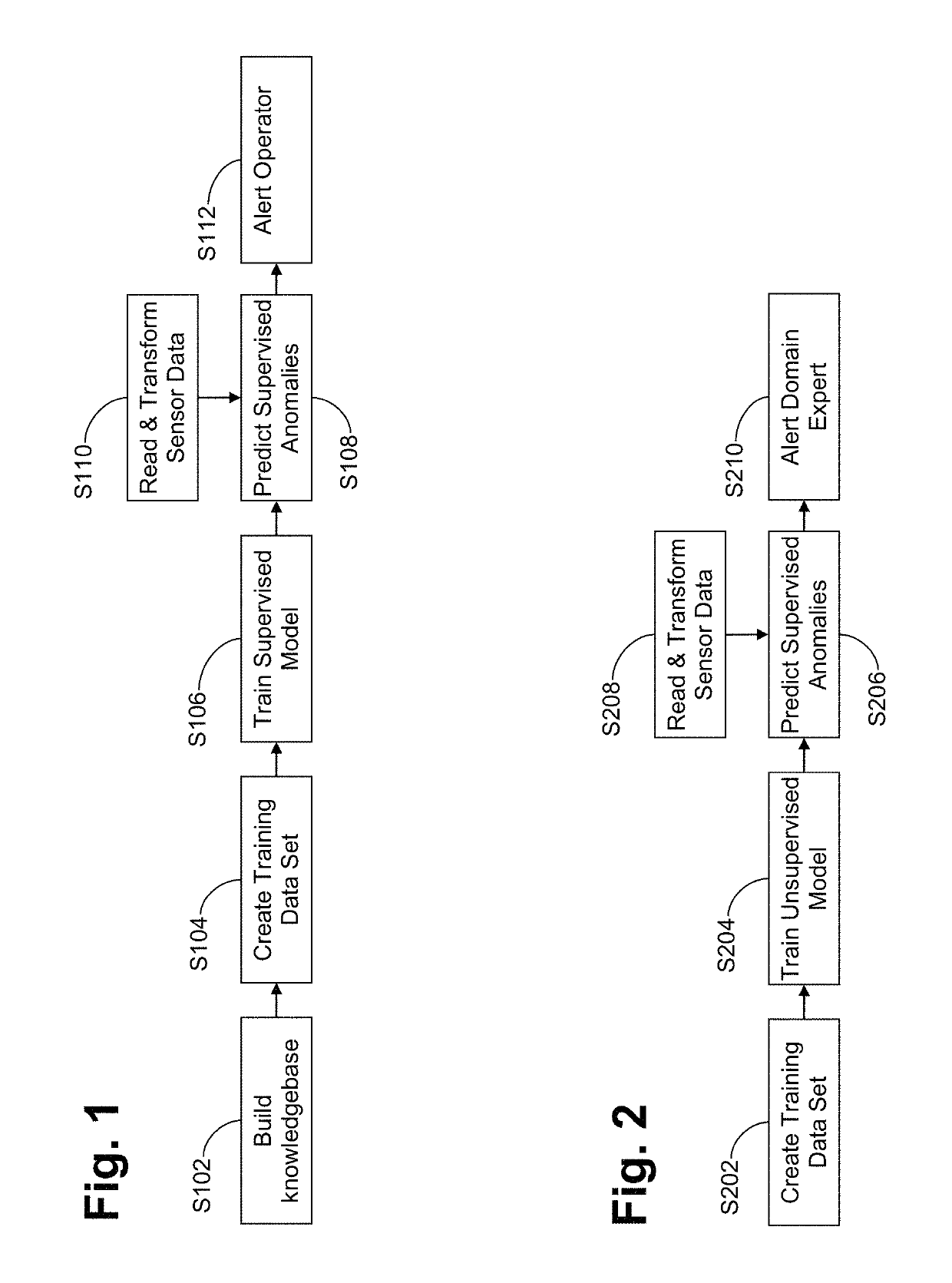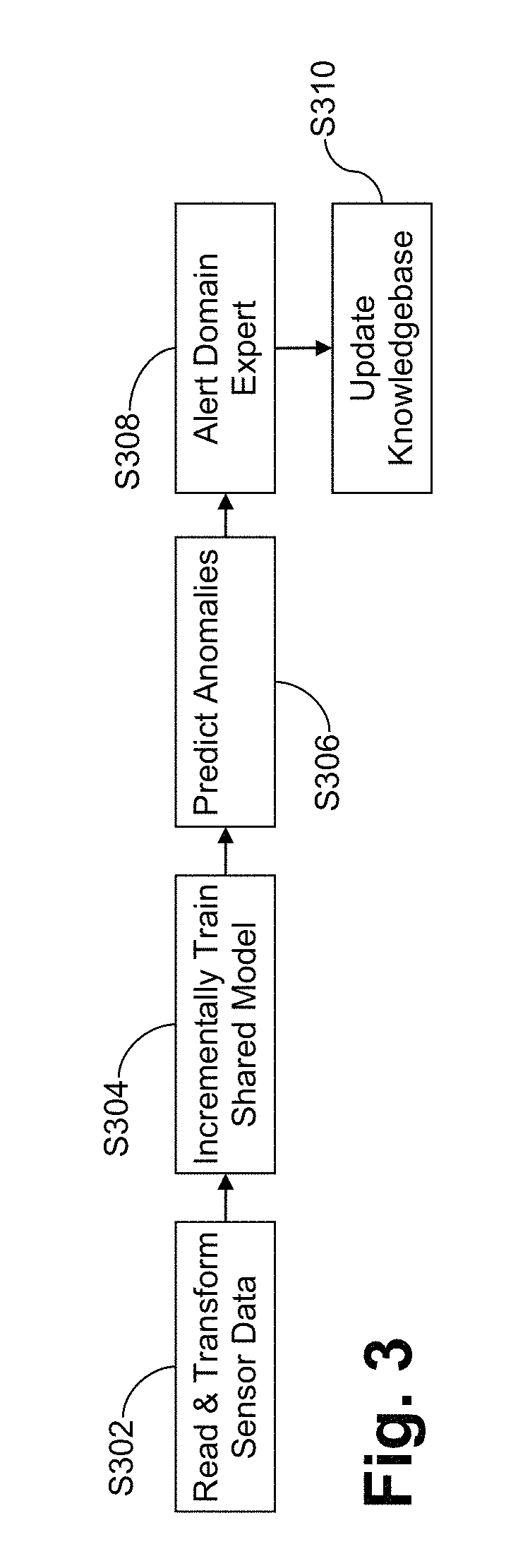Indeed, streaming data typically includes a payload from a sensor or the like along with a timestamp and typically cannot be stored because of the high volume and rate of transmission and thus must be analyzed on-the-fly.
Although this approach works adequately for some failure modes, a degradation scenario oftentimes is much more complex and is difficult to discover without a simultaneously performed analysis of data from multiple sensors, e.g., in accordance with what oftentimes is called multivariate analysis.
Thus, it will be appreciated that a machine learning algorithm uses unsupervised learning if it is able to learn something about the structure of the training data without labeled outputs.
However, in general, an assumption is made that the system primarily is performing (a) supervised learning, with the use of additional unlabeled data to increase performance, or (b) unsupervised learning, with the use of labeled data to impose additional constraints.
Its chief weakness, however, is that the number of clusters k must be known upfront.
Streaming algorithms are difficult to develop, however, as they typically need to be able to deal with the practical limits of how much data can be stored in memory and the fact that, once the data is released, there is no practical way to get it back.
It will be appreciated that both supervised and unsupervised learning approaches can suffer from the problem of concept drift, where the normal operating parameters change over time.
Concepts are often not always stable in the real world.
For instance, weather prediction rules and customers' preferences oftentimes change over time.
Thus, through naturally occurring changes, a model built on old data may become inconsistent with the new data, and / or old concepts may become inconsistent with new concepts.
The problem of concept drift, therefore complicates the task of learning.
As noted above, univariate analysis works adequately for some failures, but often the degradation scenario is much more complex and requires the simultaneous analysis of data from multiple sensors.
Also, multivariate analysis typically can detect emerging problems earlier than single-sensor thresholds, since the latter is often not detected until a component failure has already occurred.
Such knowledgebase can be expensive and time consuming to create, and these approaches typically only capture problems that have been seen before.
Multivariate unsupervised learning approaches do not require such a knowledgebase and can detect new problems, but they oftentimes suffer from false alarms being erroneously generated (e.g., as a result of detecting a rare, but not necessarily problematic, event).
They also generally cannot provide any prescriptive aid to maintenance operators.
For instance, it is oftentimes difficult or impossible to provide information, such as likely causes of the event, best course of action to remediate the problem, etc.
A disadvantage of existing supervised, unsupervised, and semi-supervised learning approaches, especially when it comes to IoT and / or similar anomaly detection, is that they require a data set of training examples (whether labeled or not) to be collected upfront before the model can be trained to start looking for anomalies.
As explained above, one weakness of the k-means algorithm is that the number of clusters k must be known upfront.
For a streaming application with machine sensor data, the number of clusters of normal and anomalous behavior is unknown, making this approach impractical.
Thus, existing streaming k-means algorithms are not well suited for use with machine sensor data.
Also, existing streaming k-means algorithms make different tradeoffs in their handling of the volume and velocity of streaming data, generally choosing either to sample it, or to process it in mini-batches.
Current machine sensor anomaly detection approaches typically do not address the problem of concept drift.
The failure to account for concept drift can eventually lead to false or missed alarms, e.g., unless the predictive model is updated.
However, knowing when to update the model often requires specific domain expertise for the machinery in question.
As a result, these approaches often degrade in accuracy and require a significant amount of maintenance.
Consider, for example, that power generation engines are expensive and complicated pieces of machinery.
Because component failure would have potentially disastrous consequences (e.g., leaving many without power for a potentially prolonged period of time), maintenance schedules for such engines generally are very conservative.
This time-based maintenance approach can waste operations time by having upkeep operations performed more frequently than is necessary, and costs are increased when items that are still serviceable are nonetheless replaced.
But building such a knowledgebase could take considerable time and expense.
Once implemented, such a system would identify significant deviations from normal engine behavior, but it likely would need to be tweaked and retrained in order to reduce the incidence of false alarms (false positives) and missed alerts (false negatives), both of which can be very expensive.
The approaches outlined in FIGS. 1-2 would eventually suffer from detection accuracy as the engine aged, because normal operating parameters for a brand new engine are different than those for one with ten thousand hours on it.
Over time, the initially empty knowledgebase may grow to cover additional (and potentially all) possible engine issues, and the need for a domain expert, as required by unsupervised learning approaches of prior and current systems, accordingly may fade away.
 Login to View More
Login to View More  Login to View More
Login to View More 


